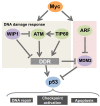Two sides of the Myc-induced DNA damage response: from tumor suppression to tumor maintenance
- PMID: 22373487
- PMCID: PMC3310713
- DOI: 10.1186/1747-1028-7-6
Two sides of the Myc-induced DNA damage response: from tumor suppression to tumor maintenance
Abstract
Activation of oncogenes is generally associated with the induction of DNA damage response (DDR) signaling, which acts as a barrier to tumor progression. In this review we will present an overview of the DDR associated with oncogenic activation of Myc, with special focus on two opposite and paradoxical aspects of this response: (1) the role of the Myc-induced DDR in tumor suppression; (2) its role in dampening Myc-induced replication stress, thereby protecting the viability of prospective cancer cells. These opposing effects on cancer progression are controlled by two different branches of DDR signaling, respectively ATM/CHK2 and ATR/CHK1. Indeed, while ATM activity constitutes a barrier to malignant transformation, full activation of ATR and CHK1 is essential for tumor maintenance, providing important opportunities for therapeutic intervention. Thus, the Myc-induced DDR acts as a double-edged sword in tumor progression.
Figures



References
LinkOut - more resources
Full Text Sources
Research Materials
Miscellaneous

